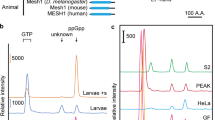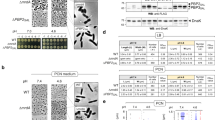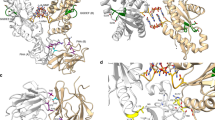Abstract
Cyclic di-(3′:5′)-guanosine monophosphate (c-di-GMP) is a major prokaryote signalling intermediate that is synthesized by diguanylate cyclases and triggers sessility and biofilm formation1,2. We detected the first eukaryote diguanylate cyclases in all major groups of Dictyostelia. On food depletion, Dictyostelium discoideum amoebas collect into aggregates, which first transform into migrating slugs and then into sessile fruiting structures3. These structures consist of a spherical spore mass that is supported by a column of stalk cells and a basal disk. A polyketide, DIF-1, which induces stalk-like cells in vitro, was isolated earlier4. However, its role in vivo proved recently to be restricted to basal disk formation5. Here we show that the Dictyostelium diguanylate cyclase, DgcA, produces c-di-GMP as the morphogen responsible for stalk cell differentiation. Dictyostelium discoideum DgcA synthesized c-di-GMP in a GTP-dependent manner and was expressed at the slug tip, which is the site of stalk cell differentiation. Disruption of the DgcA gene blocked the transition from slug migration to fructification and the expression of stalk genes. Fructification and stalk formation were restored by exposing DgcA-null slugs to wild-type secretion products or to c-di-GMP. Moreover, c-di-GMP, but not cyclic di-(3′:5′)-adenosine monophosphate, induced stalk gene expression in dilute cell monolayers. Apart from identifying the long-elusive stalk-inducing morphogen, our work also identifies a role for c-di-GMP in eukaryotes.
This is a preview of subscription content, access via your institution
Access options
Subscribe to this journal
Receive 51 print issues and online access
$199.00 per year
only $3.90 per issue
Buy this article
- Purchase on Springer Link
- Instant access to full article PDF
Prices may be subject to local taxes which are calculated during checkout




Similar content being viewed by others
References
Jenal, U. &. Malone, J. Mechanisms of cyclic-di-GMP signaling in bacteria. Annu. Rev. Genet. 40, 385–407 (2006)
Hengge, R. Principles of c-di-GMP signalling in bacteria. Nature Rev. Microbiol. 7, 263–273 (2009)
Schaap, P. The evolution of size and pattern in the social amoebas. Bioessays 29, 635–644 (2007)
Morris, H. R., Taylor, G. W., Masento, M. S., Jermyn, K. A. & Kay, R. R. Chemical structure of the morphogen differentiation inducing factor from Dictyostelium discoideum. Nature 328, 811–814 (1987)
Saito, T., Kato, A. & Kay, R. R. DIF-1 induces the basal disc of the Dictyostelium fruiting body. Dev. Biol. 317, 444–453 (2008)
Eichinger, L. et al. The genome of the social amoeba Dictyostelium discoideum. Nature 435, 43–57 (2005)
Schaap, P. et al. Molecular phylogeny and evolution of morphology in the social amoebas. Science 314, 661–663 (2006)
Chan, C. et al. Structural basis of activity and allosteric control of diguanylate cyclase. Proc. Natl Acad. Sci. USA 101, 17084–17089 (2004)
Raper, K. B. & Fennell, D. I. Stalk formation in Dictyostelium. Bull. Torrey Botan. Club 79, 25–51 (1952)
Ross, P. et al. Regulation of cellulose synthesis in Acetobacter xylinum by cyclic diguanylic acid. Nature 325, 279–281 (1987)
Blanton, R. L., Fuller, D., Iranfar, N., Grimson, M. J. & Loomis, W. F. The cellulose synthase gene of Dictyostelium. Proc. Natl Acad. Sci. USA 97, 2391–2396 (2000)
Early, A. E. et al. Structural characterization of Dictyostelium discoideum prespore- specific gene D19 and of its product, cell surface glycoprotein PsA. Mol. Cell. Biol. 8, 3458–3466 (1988)
Williams, J. G. Transcriptional regulation of Dictyostelium pattern formation. EMBO Rep. 7, 694–698 (2006)
Richardson, D. L. & Loomis, W. F. Disruption of the sporulation-specific gene spiA in Dictyostelium discoideum leads to spore instability. Genes Dev. 6, 1058–1070 (1992)
Ceccarelli, A., Zhukovskaya, N., Kawata, T., Bozzaro, S. & Williams, J. Characterisation of a DNA sequence element that directs Dictyostelium stalk cell-specific gene expression. Differentiation 66, 189–196 (2000)
Ceccarelli, A., Mahbubani, H. & Williams, J. G. Positively and negatively acting signals regulating stalk cell and anterior-like cell differentiation in Dictyostelium. Cell 65, 983–989 (1991)
Thompson, C. R. & Kay, R. R. The role of DIF-1 signaling in Dictyostelium development. Mol. Cell 6, 1509–1514 (2000)
Brookman, J. J., Town, C. D., Jermyn, K. A. & Kay, R. R. Developmental regulation of stalk cell differentiation-inducing factor in Dictyostelium discoideum. Dev. Biol. 91, 191–196 (1982)
Wang, M., Van Driel, R. & Schaap, P. Cyclic AMP-phosphodiesterase induces dedifferentiation of prespore cells in Dictyostelium discoideum slugs: evidence that cyclic AMP is the morphogenetic signal for prespore differentiation. Development 103, 611–618 (1988)
Shadwick, L. L., Spiegel, F. W., Shadwick, J. D., Brown, M. W. & Silberman, J. D. Eumycetozoa = Amoebozoa?: SSUrDNA phylogeny of protosteloid slime molds and its significance for the amoebozoan supergroup. PLoS ONE 4, e6754 (2009)
Meima, M. E., Biondi, R. M. & Schaap, P. Identification of a novel type of cGMP phosphodiesterase that is defective in the chemotactic stmF mutants. Mol. Biol. Cell 13, 3870–3877 (2002)
Harwood, A. J. & Drury, L. New vectors for expression of the E. coli lacZ gene in Dictyostelium.. Nucleic Acids Res. 18, 4292 (1990)
Dingermann, T. et al. Optimization and in situ detection of Escherichia coli beta-galactosidase gene expression in Dictyostelium discoideum. Gene 85, 353–362 (1989)
Williams, J. G. et al. Direct induction of Dictyostelium prestalk gene expression by DIF provides evidence that DIF is a morphogen. Cell 49, 185–192 (1987)
Schaap, P. et al. Cell-permeable non-hydrolyzable cAMP derivatives as tools for analysis of signaling pathways controlling gene regulation in Dictyostelium. J. Biol. Chem. 268, 6323–6331 (1993)
Paul, R. et al. Cell cycle-dependent dynamic localization of a bacterial response regulator with a novel di-guanylate cyclase output domain. Genes Dev. 18, 715–727 (2004)
Heidel, A. et al. Phylogeny-wide analysis of social amoeba genomes highlights ancient origins for complex intercellular communication. Genome Res. 21, 1882–1891 (2011)
Acknowledgements
We thank R. R. Kay for alerting us to the presence of a putative diguanylate cyclase in the D. discoideum genome. U. Jenal is gratefully acknowledged for advice and an EAL-PDE construct in an early phase of the project. We are grateful to the late H. MacWilliams for plasmids PspA-ile-gal, EcmA-ile-gal and PstO-ile-gal, and to C.Thompson for dmta− cells. We thank W. Chen and D. Lamont for mass spectrometry and C. Sugden for guidance with qRT–PCR. We are grateful to H. Urushihara and the A. subglobosum genome project (http://acytodb.biol.tsukuba.ac.jp/cgi-bin/index.cgi?org = as) for the A. subglobosum DgcA sequence. This research was supported by Wellcome Trust Project grant 090276 and BBSRC grant BB/G020426.
Author information
Authors and Affiliations
Contributions
Z.C. and P.S. designed the experiments and wrote the manuscript. Z.C. performed the experiments.
Corresponding author
Ethics declarations
Competing interests
The authors declare no competing financial interests.
Supplementary information
Supplementary Information
This file contains Supplementary Figures 1-7, Supplementary Table 1 and additional references. (PDF 4943 kb)
Supplementary Movie 1
This movie file shows the developmental phenotype of the diguanylate cyclase null mtutant. (MOV 11651 kb)
Rights and permissions
About this article
Cite this article
Chen, Zh., Schaap, P. The prokaryote messenger c-di-GMP triggers stalk cell differentiation in Dictyostelium. Nature 488, 680–683 (2012). https://doi.org/10.1038/nature11313
Received:
Accepted:
Published:
Issue Date:
DOI: https://doi.org/10.1038/nature11313
This article is cited by
-
Emerging roles for diguanylate cyclase during the evolution of soma in dictyostelia
BMC Ecology and Evolution (2023)
-
Biofilm heterogeneity-adaptive photoredox catalysis enables red light-triggered nitric oxide release for combating drug-resistant infections
Nature Communications (2023)
-
Genome and transcriptome analysis of rock-dissolving Pseudomonas sp. NLX-4 strain
Bioresources and Bioprocessing (2022)
-
Alarmones as Vestiges of a Bygone RNA World
Journal of Molecular Evolution (2019)
-
Cell-type specific RNA-Seq reveals novel roles and regulatory programs for terminally differentiated Dictyostelium cells
BMC Genomics (2018)
Comments
By submitting a comment you agree to abide by our Terms and Community Guidelines. If you find something abusive or that does not comply with our terms or guidelines please flag it as inappropriate.



